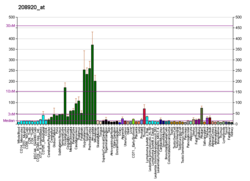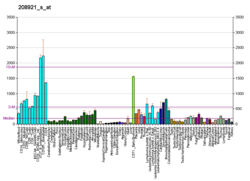Sorcin is a protein that in humans is encoded by the SRI gene.
Interactions
SRI (gene) has been shown to interact with Ryanodine receptor 2, ANXA7 and GCA.
References
- ^ GRCh38: Ensembl release 89: ENSG00000075142 – Ensembl, May 2017
- ^ GRCm38: Ensembl release 89: ENSMUSG00000003161 – Ensembl, May 2017
- "Human PubMed Reference:". National Center for Biotechnology Information, U.S. National Library of Medicine.
- "Mouse PubMed Reference:". National Center for Biotechnology Information, U.S. National Library of Medicine.
- Van der Bliek AM, Baas F, Van der Velde-Koerts T, Biedler JL, Meyers MB, Ozols RF, Hamilton TC, Joenje H, Borst P (November 1988). "Genes amplified and overexpressed in human multidrug-resistant cell lines". Cancer Research. 48 (21): 5927–32. PMID 2901906.
- "Entrez Gene: SRI sorcin".
- Meyers MB, Pickel VM, Sheu SS, Sharma VK, Scotto KW, Fishman GI (November 1995). "Association of sorcin with the cardiac ryanodine receptor". The Journal of Biological Chemistry. 270 (44): 26411–8. doi:10.1074/jbc.270.44.26411. PMID 7592856.
- Brownawell AM, Creutz CE (August 1997). "Calcium-dependent binding of sorcin to the N-terminal domain of synexin (annexin VII)". The Journal of Biological Chemistry. 272 (35): 22182–90. doi:10.1074/jbc.272.35.22182. PMID 9268363.
- Hansen C, Tarabykina S, la Cour JM, Lollike K, Berchtold MW (June 2003). "The PEF family proteins sorcin and grancalcin interact in vivo and in vitro". FEBS Letters. 545 (2–3): 151–4. doi:10.1016/S0014-5793(03)00518-0. PMID 12804766. S2CID 42572647.
Further reading
- Rasmussen HH, van Damme J, Puype M, Gesser B, Celis JE, Vandekerckhove J (December 1992). "Microsequences of 145 proteins recorded in the two-dimensional gel protein database of normal human epidermal keratinocytes". Electrophoresis. 13 (12): 960–9. doi:10.1002/elps.11501301199. PMID 1286667. S2CID 41855774.
- Meyers MB, Pickel VM, Sheu SS, Sharma VK, Scotto KW, Fishman GI (November 1995). "Association of sorcin with the cardiac ryanodine receptor". The Journal of Biological Chemistry. 270 (44): 26411–8. doi:10.1074/jbc.270.44.26411. PMID 7592856.
- Meyers MB, Zamparelli C, Verzili D, Dicker AP, Blanck TJ, Chiancone E (January 1995). "Calcium-dependent translocation of sorcin to membranes: functional relevance in contractile tissue". FEBS Letters. 357 (3): 230–4. doi:10.1016/0014-5793(94)01338-2. PMID 7835417. S2CID 28133606.
- Wang SL, Tam MF, Ho YS, Pai SH, Kao MC (February 1995). "Isolation and molecular cloning of human sorcin a calcium-binding protein in vincristine-resistant HOB1 lymphoma cells". Biochimica et Biophysica Acta (BBA) - Gene Structure and Expression. 1260 (3): 285–93. doi:10.1016/0167-4781(94)00206-i. PMID 7873602.
- Lee WP (January 1996). "Purification, cDNA cloning, and expression of human sorcin in vincristine-resistant HOB1 lymphoma cell lines". Archives of Biochemistry and Biophysics. 325 (2): 217–26. doi:10.1006/abbi.1996.0027. PMID 8561500.
- Brownawell AM, Creutz CE (August 1997). "Calcium-dependent binding of sorcin to the N-terminal domain of synexin (annexin VII)". The Journal of Biological Chemistry. 272 (35): 22182–90. doi:10.1074/jbc.272.35.22182. PMID 9268363.
- Torigoe K, Harada T, Kusaba H, Uchiumi T, Kohno K, Green ED, Scherer SW, Tsui LC, Schlessinger D, Kuwano M, Wada M (April 1998). "Localization of 67 exons on a YAC contig spanning 1.5 Mb around the multidrug resistance gene region of human chromosome 7q21.1". Genomics. 49 (1): 14–22. doi:10.1006/geno.1997.5200. PMID 9570944.
- Meyers MB, Puri TS, Chien AJ, Gao T, Hsu PH, Hosey MM, Fishman GI (July 1998). "Sorcin associates with the pore-forming subunit of voltage-dependent L-type Ca2+ channels". The Journal of Biological Chemistry. 273 (30): 18930–5. doi:10.1074/jbc.273.30.18930. PMID 9668070.
- Pack-Chung E, Meyers MB, Pettingell WP, Moir RD, Brownawell AM, Cheng I, Tanzi RE, Kim TW (May 2000). "Presenilin 2 interacts with sorcin, a modulator of the ryanodine receptor". The Journal of Biological Chemistry. 275 (19): 14440–5. doi:10.1074/jbc.M909882199. PMID 10748169.
- Xie X, Dwyer MD, Swenson L, Parker MH, Botfield MC (December 2001). "Crystal structure of calcium-free human sorcin: a member of the penta-EF-hand protein family". Protein Science. 10 (12): 2419–25. doi:10.1110/ps.36701. PMC 2374028. PMID 11714909.
- Li G, Tan Y, Yang C, Zhao C, Zhao H, Wang J, Xue Y, Han M, Qian L, Zhao C (July 2002). "Expression and clinical implication of soluble resistance-associated calcium-binding protein gene and multi-drug resistance gene in leukemia". Zhonghua Zhong Liu Za Zhi . 24 (4): 370–4. PMID 12408767.
- Li G, Tan Y, Yang C, Zhao C, Zhao H, Wang J, Xue Y, Han M, Qian L, Zhao C (June 2002). "Expression and clinical implications of the soluble drug resistance-related calcium-binding protein (sorcin) gene in leukemia patients". Zhonghua Xue Ye Xue Za Zhi = Zhonghua Xueyexue Zazhi. 23 (6): 293–6. PMID 12411058.
- Meyers MB, Fischer A, Sun YJ, Lopes CM, Rohacs T, Nakamura TY, Zhou YY, Lee PC, Altschuld RA, McCune SA, Coetzee WA, Fishman GI (August 2003). "Sorcin regulates excitation-contraction coupling in the heart". The Journal of Biological Chemistry. 278 (31): 28865–71. doi:10.1074/jbc.M302009200. PMID 12754254.
- Hansen C, Tarabykina S, la Cour JM, Lollike K, Berchtold MW (June 2003). "The PEF family proteins sorcin and grancalcin interact in vivo and in vitro". FEBS Letters. 545 (2–3): 151–4. doi:10.1016/S0014-5793(03)00518-0. PMID 12804766. S2CID 42572647.
- Colland F, Jacq X, Trouplin V, Mougin C, Groizeleau C, Hamburger A, Meil A, Wojcik J, Legrain P, Gauthier JM (July 2004). "Functional proteomics mapping of a human signaling pathway". Genome Research. 14 (7): 1324–32. doi:10.1101/gr.2334104. PMC 442148. PMID 15231748.
- Frank KF, Bölck B, Ding Z, Krause D, Hattebuhr N, Malik A, Brixius K, Hajjar RJ, Schrader J, Schwinger RH (April 2005). "Overexpression of sorcin enhances cardiac contractility in vivo and in vitro". Journal of Molecular and Cellular Cardiology. 38 (4): 607–15. doi:10.1016/j.yjmcc.2005.01.011. PMID 15808837.
- Pope SN, Lee IR (February 2005). "Yeast two-hybrid identification of prostatic proteins interacting with human sex hormone-binding globulin". The Journal of Steroid Biochemistry and Molecular Biology. 94 (1–3): 203–8. doi:10.1016/j.jsbmb.2005.01.007. PMID 15862967. S2CID 9746088.
| PDB gallery | |
|---|---|
This article on a gene on human chromosome 7 is a stub. You can help Misplaced Pages by expanding it. |








